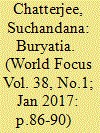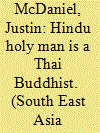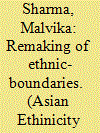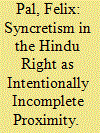|
|
|
Sort Order |
|
|
|
Items / Page
|
|
|
|
|
|
|
| Srl | Item |
| 1 |
ID:
123924


|
|
|
|
|
| Publication |
2013.
|
| Summary/Abstract |
In Turkey, the Alevi cultural 'revival' of the 1990s has been followed by a multifaceted identity-formation process that involves conflicting religio-cultural agendas, intersecting discourses and differing politico-ideological affiliations. Lacking a focus, this process continues to trigger an enriching public debate on Alevi identity, which has been coined an 'enigma' and is considered to be associated with 'ambiguity' and 'ambivalence' by many. What lies beneath the veil of ambiguity has to do with the 'anti-essentialist' transformation of Alevism, which reaches beyond religious, cultural and political orthodoxies. As a result of diverse political loyalties, contestation of discourses on Alevi culture and identity and the equivocal character of the Alevi subject, the Alevis seem to be resisting essentialism. In urban Turkey, an anti-essentialist discourse potentially influencing Alevism, I argue, enables the Alevi self to act with a sense of reflexivity and to search for ways to avoid political, cultural or religious orthodoxies.
|
|
|
|
|
|
|
|
|
|
|
|
|
|
|
|
| 2 |
ID:
150551


|
|
|
|
|
| Summary/Abstract |
The new narratives in Buryatia indicate both continuities and discontinuities—on the one hand there is an affirmation of Siberia’s Russian legacy and an understanding of multiple narratives of encounter and resilience. On the other hand, there is recognition of the mechanisms of integration in the Buryat space: be it a pan-Mongol domain, a shamanist tradition, or a Buddhist spirituality.
|
|
|
|
|
|
|
|
|
|
|
|
|
|
|
|
| 3 |
ID:
122904


|
|
|
|
|
| Publication |
2013.
|
| Summary/Abstract |
Looking closely at the figures of the Brahmin and the hermit in Thai Buddhism, the author argues that, despite the prevalence of these figures in modern and pre-modern Thai art, literature and ritual, it should not be assumed that the presence of statues of Brahmins, hermits, or deities such as Indra, Siva, Laksmi, Ganesa and Brahma represents the presence of 'Hindu' influence or Hinduism in Thailand. The author argues that when we separate Hindu figures from the study of Thai Buddhist practice we do not see them as part of Thai Buddhism.
|
|
|
|
|
|
|
|
|
|
|
|
|
|
|
|
| 4 |
ID:
185967


|
|
|
|
|
| Summary/Abstract |
Being an Ethnic-Pahari-Sikh-Borderlander in Poonch, Jammu and Kashmir is a phenomenon that adds to the discourse of ethnicity and nationalism. Partition of the Indian sub-continent in 1947 acted as a disruption in the socio-political history of the ethnic-community of Poonch generating difference and othering. This led to a newer set of challenges that re-imagines the concept of ethnicity altogether. Through an ethnographic account of the religiously assertive Sikh-identity in Poonch, this study asks the questions: Can the religious-reassertion of identities in a community render a concept as giant as ethnicity a myth? What happens to the historic origins of ethnic-bonds when identities begin to organise themselves exclusively on religious lines? Identities in Poonch exist at crossroads where being a religious Sikh challenge the idea of an ethno-geographic Sikh, both of them trying to co-exist under a bigger identity of being a borderlander.
|
|
|
|
|
|
|
|
|
|
|
|
|
|
|
|
| 5 |
ID:
128878


|
|
|
|
|
| Publication |
2014.
|
| Summary/Abstract |
This article, partly based on fieldwork with the Saibaba Sansthan of Shirdi, examines the complex interplay of syncretism, pilgrimage and associated Hinduisation which contributes to the contemporary countenance of the Sansthan, its recreation and recasting of Saibaba memories and the transposing of Shirdi social geographies. Through syncretism and pilgrimage, eventually usurped by the dominant Hindu majoritarian lens, Saibaba devotionalism complements the contemporary theoretical work on 'lived religion'. The Sansthan traditions not only supply relevant doctrines, narratives and belief systems but also embodied technologies through which the moral subjectivities of Saibaba devotees can be transformed. Akin to Bourdieu's concepts of practice and habitus, the Sansthan's doctrines shape the moral and faith-oriented selves of devotees while working towards a kind of holism wherein the goal is not solely individual spiritual enhancement but much more.
|
|
|
|
|
|
|
|
|
|
|
|
|
|
|
|
| 6 |
ID:
184238


|
|
|
|
|
| Summary/Abstract |
Religious syncretism can function as an instrument of inter-group control and domination. Rather than consistently promoting cross-religious forbearance and knowledge, syncretism enables a proximity that allows forms of violence otherwise inaccessible to religious majoritarian groups. By choreographing performances of syncretism between themselves and a subordinate religious community, organizations like the Indian Hindu nationalist Rashtriya Swayamsevak Sangh (RSS) produce an intentionally incomplete proximity. This proximity draws close minority groups like the RSS’ Muslim wing, the Muslim Rashtriya Manch, but without allowing final inclusion or incorporation. Muslim proximity to the RSS becomes a spectacle of humiliation and domination rather than a measure of inclusion into the Hindu right. Muslims must perform Hindu nationalist religious rituals, while denigrating mainstream Islamic tradition. Drawing on extensive interview-based fieldwork with the RSS and the Manch, I argue that syncretism can function as domination because it reinforces ethnic hierarchies, but that this domination is not a form of hierarchical encompassment. Rather, subordinate religious groups are kept in a perpetual humiliating limbo as a way to reify the superiority of a dominant religious group.
|
|
|
|
|
|
|
|
|
|
|
|
|
|
|
|
|
|
|
|
|